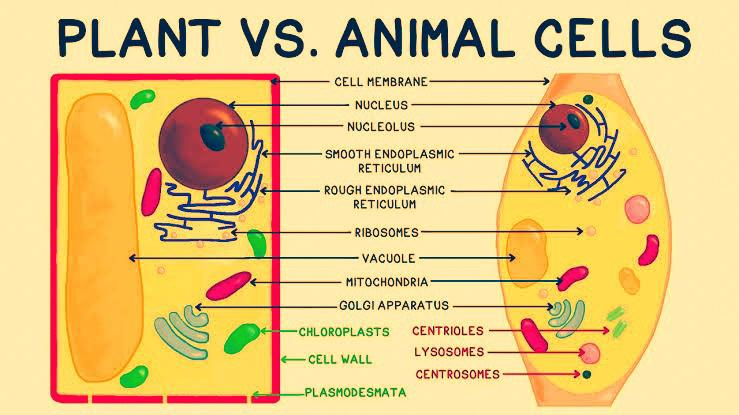
With the help of a neat labeled diagram differentiate ‘Plant Cell’ from ‘Animal’ cell.
Answer
484.8k+ views
Hint: Plants and animals both are complex organisms. Plants are sessile while animals show locomotion. Plants can synthesize their food while animals cannot. All these differences arise due to the differences in their cellular structures.
Complete answer:
The major differences between plant and animal cells are summarised in the table below:

Note: Even though plant and animal cells share many differences both of them are similar in having eukaryotic cells. The ability to perform photosynthesis is usually seen in organisms belonging to kingdom Plantae, but certain other organisms belonging to kingdom Monera, kingdom Protista, etc can also perform photosynthesis. Euglena is an organism that exhibits both plant and animal-like characters, and a mixotrophic mode of nutrition is observed. These are heterotrophic when food is available but become photosynthetic or autotrophic when food is not available. Both plants and animals have semi - autonomous cell organelles, chloroplast in plants, and mitochondria in animals.
Complete answer:
The major differences between plant and animal cells are summarised in the table below:
| Plant Cell | Animal Cell |
| A rigid cell wall is present in plant cells | The cell wall is absent in animal cells |
| Mature plant cells have a large central vacuole | Numerous small vacuoles may be present in animal cell |
| The nucleus is present at the periphery of cytoplasm due to central vacuole | The nucleus lie centrally in most cases |
| Centrioles are not present | Centrioles are present |
| Anastral spindle formation occurs during cell division | Amphiastral spindle formation occurs during cell division |
| The Golgi apparatus in plant cells is composed of a number of distinct and unconnected units called dictyosomes | Golgi apparatus is either localized or diffused and exists as a well developed single complex |
| Reserve food materials include fat and starch | Reserve food material includes glycogen and fat |
| Adjacent cells have cytoplasmic connections known as plasmodesmata | Adjacent cells are connected by cell junctions like tight junctions, gap junctions, etc. |
| Cytokinesis takes place by cell plate formation | Cytokinesis occurs by cleavage. |
| Plastids are found within plant cells | Plastids are absent within plant cells |

Note: Even though plant and animal cells share many differences both of them are similar in having eukaryotic cells. The ability to perform photosynthesis is usually seen in organisms belonging to kingdom Plantae, but certain other organisms belonging to kingdom Monera, kingdom Protista, etc can also perform photosynthesis. Euglena is an organism that exhibits both plant and animal-like characters, and a mixotrophic mode of nutrition is observed. These are heterotrophic when food is available but become photosynthetic or autotrophic when food is not available. Both plants and animals have semi - autonomous cell organelles, chloroplast in plants, and mitochondria in animals.
Recently Updated Pages
Master Class 12 Economics: Engaging Questions & Answers for Success

Master Class 12 Maths: Engaging Questions & Answers for Success

Master Class 12 Biology: Engaging Questions & Answers for Success

Master Class 12 Physics: Engaging Questions & Answers for Success

Master Class 9 General Knowledge: Engaging Questions & Answers for Success

Master Class 9 English: Engaging Questions & Answers for Success

Trending doubts
Assertion The planet Neptune appears blue in colour class 10 social science CBSE

What is the role of NGOs during disaster managemen class 9 social science CBSE

The planet known as the blue planet is the A Earth class 6 physics CBSE

Distinguish between the following Ferrous and nonferrous class 9 social science CBSE

One Metric ton is equal to kg A 10000 B 1000 C 100 class 11 physics CBSE

Change the following sentences into negative and interrogative class 10 english CBSE




